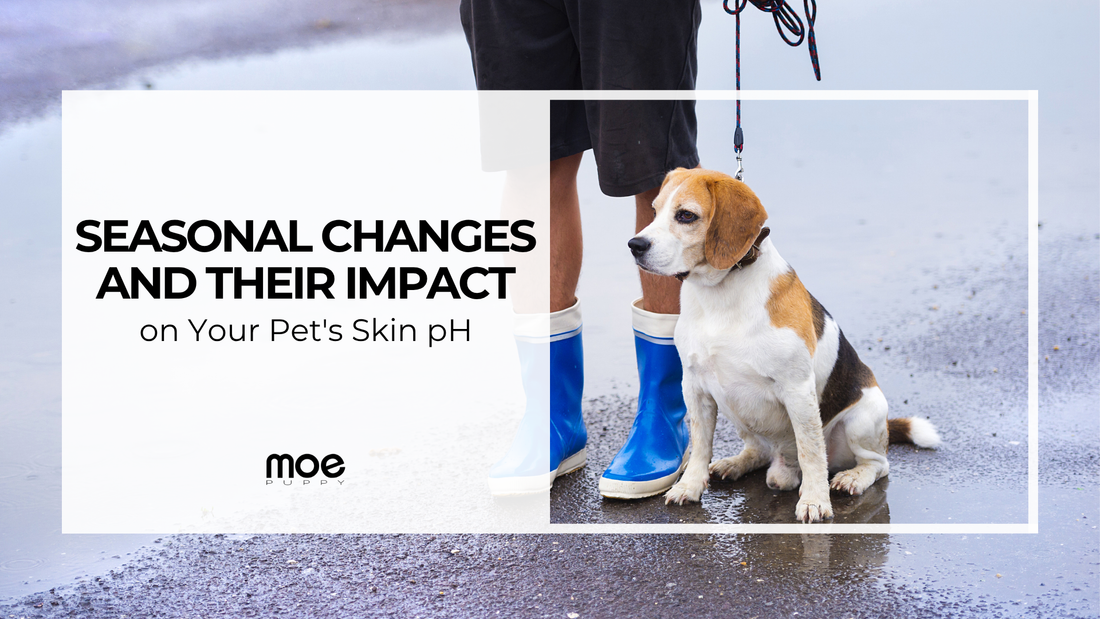
Seasonal Changes and Their Impact on Your Pet's Skin pH
Share
As pet parents, we often prepare for seasonal changes by adjusting our wardrobes, skincare routines, and even diets. But did you know that our pets also experience shifts during seasonal transitions—especially when it comes to their skin? One of the most overlooked aspects of pet care is how changing seasons affect pet skin health, particularly the skin pH levels. With summer and monsoon seasons becoming more prolonged and intense in many regions, it's essential to understand how these changes can impact your furry companion's skin and what you can do to help.
Understanding Pet Skin and pH Balance
Before diving into seasonal effects, let’s grasp what skin pH means. The skin's pH is a measure of how acidic or alkaline it is. For humans, the skin tends to be slightly acidic, around 5.5. For pets—particularly dogs and cats—the normal skin pH varies, often ranging from 6.2 to 7.5, depending on breed, age, and individual biology.
This pH range helps maintain the protective barrier on the skin's surface known as the acid mantle. The acid mantle helps prevent the growth of harmful bacteria, maintains hydration, and supports healthy skin function. Any significant shift in this pH level can disturb the skin’s natural defense system, making it vulnerable to infections, allergies, dryness, or oiliness.

Summer and Pet Skin pH: Heat, Sweat, and Humidity
Summer, with its intense heat and rising humidity, is not just uncomfortable for humans—it also puts a lot of stress on your pet’s skin. Dogs and cats don’t sweat like we do. They sweat minimally through their paw pads and mostly cool down via panting. However, they are still susceptible to the effects of high temperatures and environmental conditions.
Effects of Summer on Pet Skin:
-
Increased Oil Secretion: The sebaceous (oil) glands in your pet’s skin may become more active in the summer, especially in humid conditions. This can lead to excess oil on the skin, which may disturb the pH balance, particularly making the skin more alkaline and prone to fungal infections.
-
Dry and Itchy Skin: Ironically, while some pets become oily, others may experience dry skin due to exposure to air conditioning, sunbathing, or frequent baths. Excess bathing with harsh shampoos can strip the natural oils and disturb the pH, leading to flakiness and irritation.
-
Increased Risk of Parasites: Fleas, ticks, and mites thrive during warmer months. Infestations can lead to excessive scratching, causing micro-abrasions on the skin, which can change the local pH and allow bacterial or yeast overgrowth.
-
Sunburn and Heat Rash: Pets with thin fur or light-colored coats are especially at risk of sunburn. Damaged skin has an altered pH and is more prone to infection and inflammation.
Monsoon and Pet Skin pH: Moisture, Mold, and More
Monsoon brings much-needed relief from summer heat but creates a different set of challenges for pet skin health. The wet season is characterized by high moisture levels, muddy walks, damp fur, and reduced sunlight—all of which can affect your pet's skin condition and its natural balance.
Effects of Monsoon on Pet Skin:
-
Fungal and Bacterial Infections: Moisture is the perfect breeding ground for yeast and bacteria. If your pet’s fur remains damp after a walk or a bath, the chances of infections rise significantly. These microbes thrive in skin folds, paw pads, and under the tail—areas where the pH balance is already delicate.
-
Hot Spots and Dermatitis: Also known as acute moist dermatitis, hot spots are red, inflamed, oozing patches that develop rapidly in moist environments. These areas often become more alkaline, allowing bacteria to grow unchecked.
-
Paw Problems: Constant exposure to puddles and wet surfaces can lead to inflammation and infection between the toes. The pH of the paw skin changes with constant moisture and dirt exposure, sometimes becoming too acidic or too alkaline.
-
Increased Shedding: Some pets shed more during the monsoon, causing dead hair to clog the skin’s surface. This can trap moisture and disturb the skin’s natural pH, making it prone to dandruff or odor.

How to Support Healthy Pet Skin pH Across Seasons
The good news is that with a bit of proactive care, you can help maintain your pet’s skin pH and overall health, even with dramatic seasonal changes.
1. Season-Appropriate Grooming
Use pH-balanced shampoos specifically formulated for pets. Never use human shampoos on dogs or cats, as their pH needs are very different. During summer, you might need to bathe your pet more frequently to manage oiliness, but opt for moisturizing, pH-friendly products. In monsoon, dry shampoos or anti-fungal powders can help absorb excess moisture.
2. Proper Drying
Always dry your pet thoroughly after walks, baths, or getting caught in the rain. Pay attention to ears, paws, and skin folds. Excess moisture not only disrupts the skin barrier but also creates the ideal environment for fungi and bacteria.
3. Balanced Nutrition
Your pet’s diet directly affects their skin health. Omega-3 and Omega-6 fatty acids support skin barrier function and help regulate sebum production. During seasons of stress (like heat waves or prolonged dampness), consider skin-supporting supplements with your vet’s advice.
4. Paw and Coat Care
Clean your pet’s paws after every outdoor visit. You can use mild, vet-approved wipes or lukewarm water. Keep fur trimmed (especially for long-haired breeds) to avoid matting, which can trap moisture and dirt and shift pH levels. Small additions to your routine—like the right shampoo, paw balm an make a significant difference in maintaining pH balance
5. Monitor for Signs of Imbalance
Watch for signs like persistent scratching, redness, unusual odor, hair loss, or changes in the coat’s texture. These may indicate a shift in your pet’s skin pH and an early sign of infection or irritation.
6. Environmental Hygiene
While we clean our homes regularly, monsoon dampness and summer dust often settle into your pet’s bedding, toys, and favorite corners. This not only affects their health through allergens but also creates a breeding ground for bacteria that can transfer to their skin.
This is especially important if your pet already suffers from allergies or has sensitive skin. You may be fixing external symptoms without addressing environmental triggers. Use Pet safe disinfectant to remove those bacteria and keep you pet safe
When to See a Vet
Sometimes, despite all efforts, your pet might still develop skin issues due to pH imbalances caused by seasonal extremes. If the condition persists or worsens, consult a veterinarian. They may suggest topical treatments, medicated shampoos, or even internal medication to restore the skin’s normal balance.
Also Read: Seasonal Shedding in Dogs: What to Expect and How to Handle It
Final Thoughts
Pet skin is far more sensitive to environmental changes than we often assume. Seasonal transitions, especially the oscillation between summer and monsoon, can significantly affect the pH level of your pet’s skin. This in turn influences how well the skin can protect itself from infections, dryness, and irritation.
Being mindful of the subtle signs, adopting a grooming routine suited to the season, and focusing on prevention can go a long way in keeping your furry friend’s skin happy and healthy. Remember, balanced pet skin pH isn't just about comfort—it's a key aspect of their overall health and immunity.
By understanding how nature's rhythm affects your pet, you can tailor your care to support them through every weather shift, ensuring that their skin stays just as resilient as their love for you.

